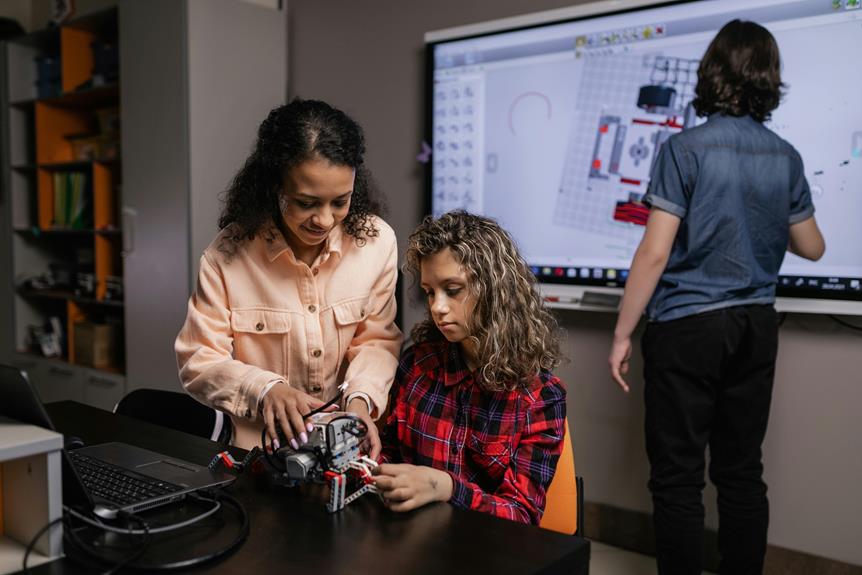Gamification in urban planning involves the integration of game design principles to improve community engagement and decision-making processes. Through interactive elements and strategies that promote player involvement, it cultivates creativity, encourages innovative thinking, and facilitates collaboration among residents and stakeholders. This approach transforms traditional urban planning methods into engaging experiences that empower communities through their active participation and contributions to inclusive decision-making processes.
By leveraging virtual and augmented reality technologies, gamification enables residents to visualize and actively participate in the development of vibrant and sustainable urban environments. The exploration of gamification's potential in urban planning highlights its role in revolutionizing city design practices and promoting collaborative efforts towards creating inclusive and sustainable urban spaces.
Key Takeaways
- Enhances community engagement through interactive experiences.
- Promotes sustainable development practices with gamified tools.
- Fosters creativity and innovation in urban projects.
- Encourages inclusive and effective planning decisions.
- Empowers communities through gamification techniques.
Benefits of Gamification in Urban Planning
The integration of gamification techniques within urban planning processes enhances community engagement and promotes sustainable development practices.
By increasing participation, gamification fosters creativity among residents, encouraging them to contribute innovative ideas for urban projects.
This approach not only empowers communities to shape their environments but also leads to more inclusive and effective planning decisions that cater to diverse needs and preferences.
Engaging Communities Through Gamification
Engaging communities through gamification in urban planning offers significant benefits, such as increased community involvement and participation. By incorporating interactive elements into the planning process, city officials can gather valuable insights and feedback from residents, leading to more inclusive and effective urban development strategies.
This approach fosters collaboration between stakeholders and encourages a sense of ownership within the community, ultimately resulting in more sustainable and resilient cities.
Community Involvement Benefits
By involving communities in urban planning through gamification, stakeholders can actively participate in decision-making processes, fostering a sense of ownership and collaboration.
- Community empowerment through active involvement
- Enhanced engagement levels among residents
- Increased social impact through collective decision-making
- Strengthened sense of ownership and responsibility
- Empowerment of marginalized voices within the community
Interactive Urban Planning
Through the utilization of gamification techniques, urban planning processes are transformed into interactive experiences that actively engage communities in decision-making and design.
Virtual reality and augmented reality tools play an important role in this transformation, allowing residents to visualize and participate in the planning process.
Leveraging Game Design Elements Effectively
To effectively leverage game design elements in urban planning, it is important to focus on three key points:
- Player engagement strategies
- Reward system implementation
- Progress tracking techniques
By understanding how to engage players, incentivize participation, and monitor progress, urban planners can create more interactive and impactful experiences for communities.
These elements can enhance citizen involvement, leading to more successful and sustainable urban development projects.
Player Engagement Strategies
Effectively leveraging game design elements is essential in implementing player engagement strategies in urban planning. To enhance user experience and motivation techniques, consider the following strategies:
- Personalized feedback to players
- Progress tracking and goal setting
- Interactive challenges and puzzles
- Social collaboration opportunities
- Real-time updates and notifications
Reward System Implementation
Building upon player engagement strategies, the successful implementation of a reward system in urban planning involves adeptly integrating game design elements to incentivize and motivate participants.
An effective incentive structure can include achievement badges awarded for completing specific tasks or reaching milestones within the planning process. These badges not only acknowledge progress but also serve as tangible rewards, encouraging continued engagement and fostering a sense of accomplishment among participants.
Progress Tracking Techniques
Leveraging game design elements effectively, urban planners can employ innovative progress tracking techniques to enhance participant engagement and facilitate efficient urban planning processes.
- Data visualization: Presenting urban development data in visually appealing formats.
- Feedback loops: Establishing mechanisms for continuous input and response.
- Task completion tracking: Monitoring and displaying progress on specific urban planning tasks.
- Leaderboards: Ranking participants based on their contributions.
- Achievement badges: Awarding virtual badges for reaching milestones.
Enhancing Decision-Making With Gamification
Through the incorporation of gamification elements, urban planning professionals can greatly enhance the decision-making processes involved in shaping sustainable and efficient urban environments. By improving engagement and driving innovation, gamification tools offer a dynamic approach to urban planning. The table below illustrates how specific gamification elements can be utilized to enhance decision-making in urban planning.
| Gamification Element | Purpose | Example |
|---|---|---|
| Leaderboards | Foster competition | Top user for eco-friendly initiatives |
| Progress Bars | Track task completion | % completion of green spaces |
| Achievements | Encourage milestones | Sustainable transportation badge |
Promoting Collaboration Through Interactive Challenges
To facilitate a more interconnected approach within urban planning initiatives, integrating interactive challenges can serve as a catalyst for promoting collaboration among stakeholders and fostering a cohesive environment for decision-making.
- Team building: Encourages teamwork and communication.
- Competition dynamics: Drive participants to aim for excellence.
- Social interaction: Enhances relationships and networking.
- Problem-solving incentives: Motivate creative solutions.
- Engagement: Increases active participation and interest.
Making Urban Development More Inclusive
In order to enhance the inclusivity of urban development initiatives, prioritizing accessibility and diversity in decision-making processes is vital. Inclusive engagement and participatory design are pivotal aspects that empower communities to have a voice in shaping their urban environments. Here is a table showcasing key strategies for making urban development more inclusive:
| Strategies | Description | Benefits |
|---|---|---|
| Inclusive Engagement | Involving diverse community members in planning | Enhanced community buy-in and support |
| Participatory Design | Collaborating with residents on design decisions | Tailored solutions to local needs |
| Accessibility | Ensuring spaces and services cater to all individuals | Enhanced usability and inclusivity |
| Diversity | Representing various cultural perspectives | Richer and more vibrant urban spaces |
| Equity | Addressing social disparities in urban planning | Promoting fairness and social cohesion |
Creating Sustainable and Vibrant Urban Spaces
Enhancing the sustainable development of urban spaces involves implementing innovative strategies that promote environmental stewardship and community liveliness.
- Utilizing sustainable design principles for infrastructure development.
- Engaging residents in urban planning decisions through community workshops.
- Incorporating green spaces and pedestrian-friendly infrastructure.
- Promoting mixed land use to encourage vibrant neighborhoods.
- Implementing renewable energy solutions to reduce carbon footprint.
Applications of Gamification in City Design
As a cutting-edge approach in urban planning, gamification offers innovative ways to engage communities and stakeholders in the design and development of cities.
Urban gamification integrates game elements into city design processes, enhancing participation and fostering creativity in urban planning initiatives.









































